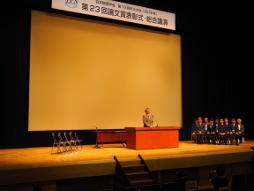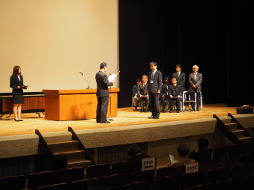[Japanese page]
Each year, in recognition of important achievements in physics, the Physical Society of Japan (JPS) selects a few outstanding papers from original research articles published in the last ten years in the Journal of the Physical Society of Japan, Progress of Theoretical Physics, Progress of Theoretical and Experimental Physics, and JPS Conference Proceedings. The selection committee has chosen four papers for the 2018 award from nominations made by the editors of the JPS journals and the representatives of 19 divisions of the JPS. The 2018 award ceremony was held on the morning of March 24, 2018 at Noda City Culture Hall (Nodashi Bunkakaikan). The four selected papers together with their citations follow.


| Title of Article |
Energy-momentum tensor from the Yang-Mills gradient flow |
|---|
| Journal |
Prog. Theor. Exp. Phys. 2013, 083B03 (2013)
[Erratum: Prog. Theor. Exp. Phys. 2015, 079201 (2015)] |
|---|
| Authors |
Hiroshi Suzuki |
|---|
| Citation |
The lattice gauge theory has been important in formulating quantum field theory in a nonperturbative manner. Among other uses, lattice quantum chromodynamics (QCD) has been successfully applied in studying the properties of hadrons. However, the lattice field theory has difficulty to define the energy-momentum tensor which is a Noether current associated with the translational invariance of spacetime, as the lattice regularization breaks the continuous spacetime symmetry. Thus, it has been difficult to obtain reliable results on the energy-momentum tensor and its correlation functions. One way to rigorously define the energy-momentum tensor on the lattice is to utilize physical quantities that are free from ultraviolet divergence. The author applied the Yang-Mills gradient flow method to construct the ultraviolet finite energy-momentum of the Yang-Mills theory in a nonperturbative way. In this approach, in addition to the four-dimensional (Euclidean) spacetime, a "flow time" is introduced. Following a kind of diffuse equation, the configurations of the Yang-Mills field diffuse as the flow time develops. For a positive flow time, the energy-momentum tensor and its correlation functions become ultraviolet finite. The paper presented a formalism to extrapolate into the zero flow time, with the relations explicitly calculated. After publishing this paper, the author extended this method to the case where a Dirac field is included, and therefore provided a definition of the energy-momentum tensor for a more general lattice gauge theory. The author's work established a methodology to define the energy-momentum tensor, one of the most fundamental physical quantities, in a nonperturbative way, which has been highly appreciated. It has already become one of the standard references on this subject and has had a major impact on subsequent research. It is expected that this methodology will be applied to the investigation of various physical quantities, such as the structure of hadrons, the evaluation of thermodynamic quantities, and the viscosity of quark-gluon plasma. Hence, we conclude that it deserves the Outstanding Paper Award of the Physical Society of Japan.
|
|---|
| Title of Article |
Kondo Effects and Multipolar Order in the Cubic PrTr2Al20 (Tr = Ti, V) |
|---|
| Journal |
J. Phys. Soc. Jpn. 80, 063701 (2011) |
|---|
| Author |
Akito Sakai and Satoru Nakatsuji |
|---|
| Citation |
The quadrupole Kondo effect is one of the many-body effects caused by the hybridization of localized electrons having degrees of freedom of electric quadrupoles with conduction electrons. It was theoretically proposed about 30 years ago as an extension of the conventional Kondo effect arising from magnetic dipole moment. Subsequently, material search was conducted aiming at experimental observation of this phenomenon, but experimentally convincing evidence was not obtained. Along this research direction, the authors found novel properties of strongly correlated electrons considered to be due to quadrupolar degrees of freedom in a 1-2-20 compound system in which Pr ions formed a crystal lattice. The authors observed anomalous properties, such as electrical resistivity in proportion to the square root of temperature above the quadrupolar order, and pointed out the possibility of realizing a non-Fermi liquid due to the quadrupole Kondo effect. The grown PrTi2Al20 single crystal was of high purity, and various physical quantities were measured precisely. Thus, their results were highly reliable. After publication of this paper, various experiments, such as confirmation of the ground state of the Pr crystal field with quadrupolar degrees of freedom by neutron inelastic scattering and discovery of anomalous pressure-induced superconductivity, were carried out. In theoretical research, the lattice system of the quadrupolar Kondo effect was extended. As mentioned above, this paper has reported a new compound that can provide an ideal playground for exploring quadrupolar Kondo physics and has developed this new research area. This achievement therefore deserves the Outstanding Paper Award of the Physical Society of Japan.
|
|---|
| Title of Article |
Novel Phase Transition and the Pressure Effect in YbFe2Al10-type CeT2Al10 (T = Fe, Ru, Os) |
|---|
| Journal |
J. Phys. Soc. Jpn. 78, 123705 (2009) |
|---|
| Authors |
Takashi Nishioka, Yukihiro Kawamura, Tomoaki Takesaka, Riki Kobayashi, Harukazu Kato, Masahiro Matsumura, Kazuto Kodama, Kazuyuki Matsubayashi, and Yoshiya Uwatoko |
|---|
| Citation |
In general, the magnetic properties of Ce compounds are well described by the Doniach phase diagram, which shows the competition between the Kondo effect (nonmagnetic state) and the RKKY interaction (magnetic state). Therefore, Ce compounds usually show a localized magnetic state with a low transition temperature TN, a nonmagnetic valence fluctuating state and an intermediate nonmagnetic state, or a low-TN antiferromagnetic heavy fermion state. The authors of this paper have grown high-quality CeT2Al10 (T = Fe, Ru, Os) single crystals and have made detailed specific heat, electric conductivity, magnetic susceptibility, and pressure effect measurements. As a result, they showed that all of the studied compounds are Kondo semiconductors, and these compounds fall into heavy fermion states under high pressure, which suggests that these compounds may be understood systematically with pressure as the parameter. Moreover, CeRu2Al10 and CeOs2Al10 show phase transitions at approximately 30 K, which is unusually high for Ce compounds, and the phase transitions disappear at 2-4 GPa. Because these high transition temperatures near 30 K cannot be understood by the simple magnetic order considering the de Gennes factor of Ce ions, the authors suggest the possibility of the CDW transition. Moreover, the unusual aspects of these transitions may be summarized as follows. The high temperature transitions are not understandable by considering the magnetic order due to the small antiferromagnetic magnetic moments, which were revealed after this paper. The easy axis of the antiferromagnetic state does not coincide with that of the paramagnetic state. Therefore, because these compounds are difficult to understand by the conventional Doniach phase diagram, this paper has attracted much attention and has influenced many experimental and theoretical studies in the field. In summary, this paper has shown the very unusual magnetic phenomena related to Ce compounds by growing high-quality CeT2Al10 (T=Ru, Os) single crystals and by measuring the fundamental physical properties of these single crystals. Therefore, this paper has had a significant influence on subsequent experimental and theoretical studies in this field. Hence, we conclude that this paper deserves the Outstanding Paper Award of the Physical Society of Japan.
|
|---|
| Title of Article |
Comparison of Ab initio Low-Energy Models for LaFePO, LaFeAsO, BaFe2As2, LiFeAs, FeSe, and FeTe: Electron Correlation and Covalency |
|---|
| Journal |
J. Phys. Soc. Jpn. 79, 044705 (2010) |
|---|
| Authors |
Takashi Miyake, Kazuma Nakamura, Ryotaro Arita, and Masatoshi Imada |
|---|
| Citation |
It is impossible to understand the properties of strongly correlated electron systems keeping all the information of microscopic electronic structures. It is thus essential to introduce low-energy effective models, such as the Hubbard model. However, in most cases, the determination of parameters appearing in an effective model, such as the hopping amplitudes and on-site repulsive interactions, has relied on empirical values or fitting to experimental data. This has practically prevented the quantitative description of real materials based on effective models. Recently, however, the "first-principles downfolding method," in which the parameters in the effective model are determined based on first-principles calculations, has been rapidly developed. This enables the accurate description of strong correlation effects in real materials. In this paper, in a further advancement of earlier studies by the authors and other researchers, a multi-orbital Hubbard model was derived for iron-based superconductors by an application of the first-principles downfolding method without empirical inputs. As a notable improvement, maximally localized Wannier functions were used to represent electronic bands, which are relevant for low-energy excitations. Furthermore, repulsive interaction parameters were derived by constrained random-phase approximation (cRPA), taking the screening effects by high-energy excitations into account. These improvements eliminated the arbitrariness that remained unresolved in preceding studies, and enabled a systematic comparison among various material families of iron-based superconductors as reported in this paper. In particular, the authors revealed that correlation effects are strongest in the "11" family, and they elucidated the physical mechanism behind this observation. This is a notable contribution to the systematic understanding of iron-based superconductors, and it has had a considerable impact on related experimental studies. Moreover, the methods developed in this paper have been successfully applied to other strongly correlated materials. It would be fair to say that this paper established the first-principles downfolding method as a quantitative methodology. In conclusion, this paper has made a significant contribution to both physics of iron-based superconductors and to the methodological development of first-principles derivation of low-energy effective models; therefore, it deserves the Outstanding Paper Award of the Physical Society of Japan.
|
|---|


